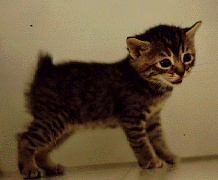Variations of the 3:1 ratio
The simple 3-to-1 monohybrid ratio is not always observed in instances where only one gene is responsible for a particular phenotype.
A number of factors:
- Partial or incomplete dominance
Complete dominance means the phenotype of first filial generation(heterozygous) is exactly identical to that of one of the parents(both homozygous). Partial or incomplete dominance means the first filial has phenotype somewhere between that of both parents.
For example, When two pure-bred snapdragons, with white and red petals respectively, cross, their first filial generation has pink petal rather than red or white.
In this case, the homozygous phenotypes are red, or white petals while heterozygous one is between white and red: pink petal.
Thus, it is conceivable that when it comes to the second filial generation, which was produced by the self fertilization of the heterozygous F1, F2 should have three different phenotypes, white, pink, and red. And we can also deduce the ratio of them is 1:2:1.
- Codominance
Codominance is similar to incomplete dominance, but here the heterozygote displays both alleles(两种等位基因均被表达).
For example, in humans the MN blood group is controlled by a single gene.
In humans the main blood group systems are the ABO system, the Rh system and theMN system.
Only two alleles exist, M and N. Children whose father is an NN homozygote with N blood and whose mother is a MM homozygote with group M blood are MN heterozygotes and have group MN blood.Both phenotypes are identifiable in the hybrid. And the ratio also switches from 3:1 to 1:2:1.
- Lethal alleles
Some alleles affect the viability of individuals that carry them.
In most cases the homozygous recessive does not survive but the heterozygotes may have a normal lifespan.
The best-known example of lethal alleles is the inheritance of yellow coat color in mice.
Yellow fur can arise in strain of mice with different colors, or instance, black. Yellow coat color is dominant to black coat. Mice with BB alleles are back, with BBy are yellow, with ByBy alleles are supposed to be yellow as well, but ByBy alleles are lethal and any mice with this genotype die in utero(in the uterus : before birth).
SO it is conceivable that when two yellow mices are mated ratio of the different phenotypes of their first generation is 2 : 1, rather than 3 : 1 or 1 : 2 :1.
NOTE: The allele By is recessive in its relation to its effect on viability (only homozygous ByBy s die, while the heterozygotes survive ), but dominant in relation to coat color(heterozygotes present in yellow fur in stead of black fur.).
Other examples where alleles are lethal when homozygous but have a dominant effect when heterozygous, include :
- tailless Manx cats

a breed of domestic cat(Felis catus) originating on the Isle of Man, with a naturally occurring mutation that shortens the tail.
The Manx taillessness gene is dominant and highly penetrant; kittens from two Manx parents are generally born without any tail. Being homozygous for the taillessnees gene is lethal in utero.Thus, tailless cats can only be heterzygous. Because of the danger of having homozygous taillessness gene, breeders avoid breeding two entirely tailless Manx cats together.(wikipedia: Manx (cat))
- short-legged Creeper chickens.
====================================================
(Annie: If none of the homozygous yellow mice can survive before birth, then where did all the heterozygous yellow mice come from in the first place???????)
Answer: Through mutation. The presence of one mutant allele alters development so as to produce characteristic changes to the animal, but when two of the mutant alleles are present, development is so aberrant as to cause death.
This may occur in utero as described above or resulted in shortened life expectancy as found in several examples in humans, such as Tay-Sachs disease, Huntington’s syndrome(亨丁顿舞蹈症) or sickle-cell anemia(镰刀形红血球病). (from Instant Notes)
